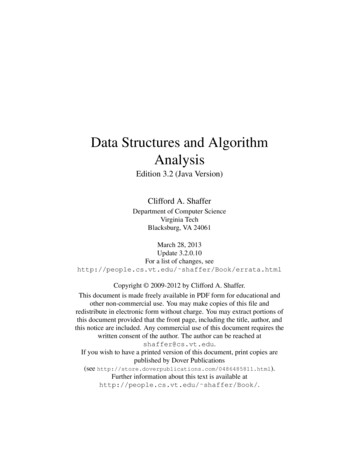
Transcription
Introduction to dsData Structures for GamesMichael Baczynskipolygonal.de01/11/121
OverviewPart 1 – Preface About ds, design goals, principles and featuresPart 2 – The Data Structures More detailed description of the included data structuresPart 3 – The Collection Interface The interface implemented by all data structures01/11/122
Preface01/11/123
What is ds?A haXe library providing basic data structuresCreated for game programmers, not computer scientistsSimple – does not compete with C STL or Java collections,yet covers most of the programmer's daily needsA learning projectProject hosting on Google Code http://code.google.com/p/polygonalDocumentation http://www.polygonal.de/doc/dsQuestions, comments, feature requests 124
Why ds?Free and open source (non-restrictive BSD license)Saves you hours of coding – game development is hard enough!Well supported & maintainedOptimized from the ground up for AVM2Pre-compiled SWC libraries for ActionScript 3.0 available nScript301/11/125
What is haXe?HaXe is high-level language developed by Nicolas CanasseSyntax similar to ActionScript and JavaCross-platform – Flash, JavaScript, PHP, C , Neko, C#, JavaTons of features – iterators, typedefs, generics, macros Homepage http://haxe.org/More http://ncannasse.fr/file/FGS2010 haxe4GD.pdf http://ui.massive.com.au/talks/01/11/126
Why haXe?Supports type parameters – no more dynamic containersclass Container T {var data:Array T ;}var container new Container String ();Supports iterators – less-boilerplate codefor (element in myContainer) { }Type inference – don't repeat yourselfvar i 3; //typed as integeri "3";//compile error: String should be IntPerformance – clever compiler optimizations Better byte code, function inlining, constant expression optimization perfect match for writing data structures!01/11/127
History2006 Wrote some basic data structures in ActionScript 2.02007 Switched to ActionScript 3.02008 Released “AS3 Data Structures for Game Developers” (as3ds)2009 Switched to the haXe language2010 Released ds, an improved version of as3ds http://lab.polygonal.de/?p 96101/11/128
Design GoalsReasonable small API Short learning curveKeep number of interfaces small– One “container” type (Collection T )– One iterator typePerformance oriented Efficient data structures lead to efficient programsFun to push boundariesImprove development cycle Human-readable error messagesAssertions01/11/129
What Are Data Structures?A way of storing and organizing data in a computerA data structure includes 1) A set of operations2) A storage organization of the data3) Algorithms that manipulate the data through 1)Examples Primitives, e.g. the built-in integer data typeArrays – a sequence of data items of the same typeObjects – a bunch of objects of various types01/11/1210
Abstract Data Type – ADTAn ADT specifies a data type & a defined set of operations No implementation details are given the “logical” levelRequires a „concrete” data structure the implementation levelThere are many ways to implement ADTs Only allowed difference is performance characteristic– How does the run time change as the number of items increases?ADTs in ds Stack T , Queue T , Deque T , Map K,T , Set T Example Stacks can be implemented by using arrays or linked listsThe behavior of a stack is an ADTBoth implementations are different data structures01/11/1211
Abstract Data Type – ADT (cont.)Objective Reduce complexity between algorithms & data structures Hide implementation details – principle of encapsulation Provide a higher-level abstraction of the problemBenefits Easier to understand Easier to organize large programs More convenient to change Less bugs!01/11/1212
Features (version 1.35)2D-, 3D-arraySingly-, Doubly-Linked ListsStack, Queue, DequeSet, MapMultiway Tree, Binary Tree, Binary Search Tree (BST)Heap, Priority QueueGraphBit vector01/11/1213
Features (cont.)All structures are of varying length (dynamic)Arrayed & linked implementationsIterative & recursive traversal algorithmsDebug build with additional assertions & check routinesCode performanceObject pooling helpersMemory manager for fast virtual memory (“alchemy”)01/11/1214
Dynamic Data StructuresAll structures in ds are dynamic A static structure has a fixed size whereas a dynamic structure automaticallygrows & shrinks with demandFlash does not release memory of shrunken arrays Setting the length property of an array to zero has no effectTo release memory, it's required to create a smaller array and copy the data overArrayed structures in ds do this automatically for the user by callingCollection.pack() or Collection.clear(true)Some collections can be made non-resizable to preventfrequent & expensive resizing if the target size is known in advance01/11/1215
Arrayed v Linkedds includes arrayed and linked versions of many data structuresArrayed – pros and cons Random access in constant timeCompact, but small arrays waste memory since allocation is done in chunksModifying array elements is expensive movement of dataPoor Flash performanceLinked – pros and cons Random access in linear timeFast insertion & deletion by adjusting pointersImplicit resizing performed by insertion/removal algorithmsAdds storage overhead per elementRequires bookkeeping of pointers that hold the structure togetherExcellent Flash performance01/11/1216
Iterative v RecursiveSome methods in ds can be invoked in a recursive or iterative mannerIterative – pros and cons Fast for small algorithms allows function inlining Implementation is usually more complex Requires a helper structure (e.g. a stack or a queue)Recursive – pros and cons Implicit use of the call stack easier to implement, fewer lines of code Generally slower due to overhead of maintaining call stack and function calls Big data sets can trigger a stack overflow due to deep recursion01/11/1217
Iterative v Recursive ExampleExample – printing all elements of a linked listIterative versionvar node head;while (node ! null) {trace(node);node node.next;}Recursive version – roughly 3x slower in Flashfunction print(node) {if (node null) 1/11/1218
Debug v Release BuildIn ds, debug-builds behave differently than release-buildsDebug build Validates user input (e.g. index out of range)Provide meaningful error messagesCatch errors early!Release build Includes only the bare minimum parts for best performanceSilently fails if something goes wrong!Even allows illegal operations that renders the structure useless!Always use the debug version during development Using haXe, compile with -debug directiveUsing ActionScript, compile against ds debug.swc01/11/1219
Debug v Release Example 1Example – popping data of an empty array silently fails in FlashUsing a flash arrayvar stack new Array Int ();stack.push(0);stack.pop();stack.pop(); //stack underflowUsing an ArrayedStack object in debug modevar stack new de.polygonal.ds.ArrayedStack Int ();stack.push(0);stack.pop();stack.pop(); //throws: Assertation 'stack is empty' failed01/11/1220
Debug v Release Example 2The “denseness” of a dense array is only checked in debug mode –boundary checking every access is expensive!Example – adding elements to a dense arrayReleasevar da new de.polygonal.ds.DA Int ();da.set(1, 100); //array is no longer dense!Debugvar da new de.polygonal.ds.DA Int ();da.set(1, 100); //throws 'the index 1 is out of range 0' failed01/11/1221
Debug v Release Example 3Some operations render a structure useless when used in certain conditionsExample – adding an element to a fixed-size, full queuePrerequisitevarvarvarfor}isResizable false;maxSize 16;que new de.polygonal.ds.ArrayedQueue Int (maxSize, isResizable);(i in 0.maxSize) {que.enqueue(i); //fill the queueReleaseque.enqueue(100); //silently overwrites an existing item!Debugque.enqueue(100); //throws: Assertion 'queue is full' failed01/11/1222
Performance GuidelinesFavor code efficiency over utilization efficiency It's far more efficient to find a dedicated, specialized method instead of re-usingand recombining existing methodsFavor interfaces over functions literals Much faster for strictly typed runtimes (Flash, C , Java, C#)Typed function calls are almost 10x faster in AVM2Use non-allocating implementations Prevent frequent allocation of short-lived objects that need to be GCedNode based structures offer built-in object poolingPrefer composition over inheritance Avoid slow casts where possible01/11/1223
Performance – Comparing ElementsExample – comparing elements using an interface (faster)Prerequisiteclass Foo implements de.polygonal.ds.Comparable Foo {public var val:Int;public function new() {}public function compare(other:Foo):Int { return val – other.val; }}UsagemyFoo.compare(otherFoo);Example – comparing elements using a function literal (slower)var compare function(a:Foo, b:Foo) { return a.val – b.val; }compare(myFoo, otherFoo);User choice!01/11/1224
Performance – Reusing ObjectsPass objects to methods for storing their output to prevent objectallocation inside methodsExample – extracting a row from a 2-dimensional arrayvar matrix new de.polygonal.ds.Array2 Int (10, 10);var output new Array Int (); //stores the resultmatrix.getRow(0, output); //output argument stores row at y 0matrix.getRow(1, output); //reuse output to store another row 01/11/1225
Object PoolingManages a set of pre-initialized objects ready to useAvoids objects being allocated & destroyed repeatedlySignificant performance boost when Class instantiation is costly Class instantiation is frequent Instantiated objects have a short life spanPerformance-memory trade-off01/11/1226
Object Pooling ImplementationObjectPool T A fixed-sized, arrayed object pool implemented as a “free list” data structureObjects are accessed by integer keysRequires to keep track of the key, not the object itselfObject can be initialized on-the-fly (lazy allocation) or in advanceDyamicObjectPool T A dynamic, arrayed object pool implemented as a stackPool is initially empty and grows automaticallyIf size exceeds a predefined limit a non-pooled object is created on-the-fly– Slower, but application continues to work as expected01/11/1227
Object Pooling ExampleExample – using an ObjectPoolimport de.polygonal.ds.pooling.ObjectPool;var capacity 1000;var pool new ObjectPool Foo (capacity);var objects new Array Int ();for (i in 0.10) {var key pool.next(); //get next free object key from the poolobjects.push(key);//keep track of those keys for later use}for (key in objects) {var foo:Foo pool.get(key); //key - objectfoo.doSomething();pool.put(key); //return object to the pool}01/11/1228
Alchemy Memory* 2011*Flash Player 11.2 will not support the experimental Alchemy prototypeAdobe Make Some Alchemy !http://ncannasse.fr/blog/adobe make some alchemy01/11/1229
Fast Alchemy MemoryAlchemy toolchain transforms C/C into ActionScript bytecodeByteArray objects are too slow for the C memory model so Adobe addedspecial opcodes for fast memory accesshaXe exposes those opcodes through a simple memory API (flash.memory.*)Exampleimport flash.utils.ByteArray;var bytes new emory.getI32(i);flash.Memory.setI32(i, x);//create 4 KiB of memory//make bytes accessible through memory api//read 32-bit integer from byte address i//write 32-bit integer x to address iMore http://ncannasse.fr/blog/virtual memory api /11/1230
Fast Alchemy Memory (cont.)Idea Create super fast arrays for number crunching with a simple APINaïve solution Use multiple ByteArray objects – each one representing an array objectCall flash.Memory.select() before accessing itProblem Calls to flash.Memory.select() are too expensiveSolution Split a single ByteArray object into smaller pieces chunks of memoryThe ByteArray is managed by a dynamic memory allocator– de.polygonal.ds.MemoryManager01/11/1231
MemoryManagerAllocating memoryMemoryManager.malloc(accessor:MemoryAccess, numBytes:Int):Void Finds a block of unused memory of sufficient size (using “first fit” allocation)A chunk of memory is represented by a MemorySegment objectConfigures accessor parameter to point to the segment's address spaceDeallocating :Void Returns used bytes to the memory pool for later use by the programBy default, memory isn't automatically reclaimed– User has to call MemoryAccess.free() in order to prevent a memory leak– If MemoryManager.AUTO RECLAIM MEMORY is true,memory is automatically reclaimed when an objectextending MemoryAccess is GCed (using weak reference hack)01/11/1232
MemoryManager (cont.)Classes using virtual memory (de.polygonal.ds.mem.*) DoubleMemoryArray storing bits (“bit vector”)Array storing bytes (fast ByteArray replacement)Array storing signed 16-bit integersArray storing signed 32-bit integersArray storing 32-bit floating point numbersArray storing 64-bit floating point numbersCross-platform compatibility Supported in Flash and C targetAlchemy opcodes are only used when compiled with -D alchemyIf omitted, flash.Vector is used as a fallbackMore http://lab.polygonal.de/?p 123001/11/1233
MemoryManager ExampleExample – basic usageimport de.polygonal.ds.mem.IntMemory;var memory new IntMemory(100);memory.set(4, 10);var x memory.get(4);memory.free();//allocates space for 100 integers//store value 10 at integer index 4//return value at index 4//deallocate once no longer neededExample – fast iterationvar memory new IntMemory(100);var offset memory.offset; //byte offset of this memory segmentfor (i in 0.100) {//integer index byte index * 4var x flash.Memory.getI32(offset i 2);}01/11/1234
The Data Structures01/11/1235
Multi-Dimensional ArraysIncludes a two- and three-dimensional arrayElements are stored in a rectangular sequential array Rows are laid out sequentially in memoryRow-major order – kind of C/C creates by default2D array index: (y * width) x3D array index: (z * width * height) (y * width) xFast – only one array access [] operation in any dimensionDense – efficient memory usage Array locations for a 3x3 matrix, stored sequentially:01/11/1236
Linked ListsSeveral objects (“nodes”) linked together A node stores a value (“cargo”) and a reference to the next (& previous) nodeNodes can be rearranged and added/removed efficientlyIn ds, nodes are managed by a list classFeatures Supports mergesort & insertionsort – latter is very fast for nearly sorted listsSupports circular listsBuilt-in node pooling to avoid node allocation (optional)More (based on as3ds) http://lab.polygonal.de/?p 20601/11/1237
Singly v Doubly Linked ListsSingly linked list (de.polygonal.ds.SLL T ) Can't traverse list backwards Can't delete item only given a reference to that node removal takes linear time Overhead: 4 extra bytes per node in Flash (reference to next node)Doubly linked list (de.polygonal.ds.DLL T ) Can be traversed either forward or backward Removal of elements in constant time Overhead: 8 extra bytes per node in Flash (reference to next & previous node)01/11/1238
Circular Linked ListsA linked list is linearly-linked (“open”) by defaultA linked list can be transformed into a circular-linked list with myList.close()When closed, null is no longer used to terminate the list –instead the tail points to the head (and v.v. for doubly-linked lists)Iterating over a circular linked list can result in an infinite loop:var node myList.head;while (node ! null) {if (node myList.tail) { //check end condition!break;}node node.next;}01/11/1239
Linked List ExampleExample – fast self-removal of list elements by cross-referencingPrerequisiteclass Foo {public var node:de.polygonal.ds.DLLNode Foo ;public function new() {}public function remove():Void {node.unlink();node null;}}Usagevar list new de.polygonal.ds.DLL Foo ();var foo new Foo();foo.node list.append(foo); foo.remove(); //remove foo from list01/11/1240
Destroying a Linked ListIt's sufficient to drop the head of the list because the garbage collector findsand reclaims all remaining nodes head null; but nullifying all references improves garbage collectionvar node head;while (node ! null) {var hook next; //don't fall of the listnode.next null; //nullify pointernode hook;}Applied by ds to all node-based collections when calling Collection.free() Memory is reclaimed earlierGC pass takes less time01/11/1241
QueueRemoves the item least recently added – “first-in-first-out” (FIFO)Minimum set of required functions (de.polygonal.ds.Queue T interface) enqueue()dequeue()peek()Inserts a new element at the end of the queueRemoves and returns the element at the beginning of the queueThe element at the beginning of the queue (that has been present the longest)Applications Waiting lines, buffer for incoming dataSimultaneous resource sharing by multiple consumersMore (based on as3ds) http://lab.polygonal.de/?p 18901/11/1242
Queue Implementationde.polygonal.ds.ArrayedQueue T A circular array – the end of array “wraps around” to the start of the arrayUses a fill count to distinguish between empty and full queuesInsertion/removal of elements in constant timeBest for fixed-sized queues resizing a circular array is expensiveUse dispose() to nullify last dequeued element to allow early garbage collectionde.polygonal.ds.LinkedQueue T Implemented as a singly-linked listFast peek() operation, but slower insertion/removalBest for queues of varying size and when maximum size is not known in advanceMore efficient than using the DLL T class for queue-like access01/11/1243
Queue ExampleExample – using a queue to buffer up to x incoming elementsimport de.polygonal.ds.ArrayedQueue;var que new ArrayedQueue MyElement (x); if (que.isFull()) {que.dequeue(); //make room by dropping the "oldest" element}q.enqueue(element); //insert incoming element//process buffered elements, from oldest to newestfor (i in 0.que.size()) {var element que.get(i); //get(0) equals peek()}01/11/1244
StackRemoves the item most recently added – “last-in-first-out” (LIFO)All insertions and removals occur at one end (“top”) of the stackMinimum set of required functions (de.polygonal.ds.Stack T interface) push()pop()top()Inserts a new element at the top of the stackRemoves and returns the element at the top of the stackThe element at the top of the stackApplications – fundamental data structure Syntax parsing, expression evaluation, stack machines Undo and backtrackingCommon errors – stack underflow & overflow Underflow – pop (or peek at) an empty stackOverflow – push onto an already full stack01/11/1245
Stack Implementationde.polygonal.ds.ArrayedStack T Insertion/removal just updates one variable (the stack pointer) fastUse dispose() to nullify last popped off element to allow early garbage collectionde.polygonal.ds.LinkedStack T Implemented as a singly-linked listFast top() operation, but slower insertion and removalMore efficient than using the SLL T class for stack-like accessMore stack methods for advanced usage dup()exchange()rotLeft(), rotRight()01/11/1246Pops the top element of the stack, and pushes it back twiceSwaps the two topmost elements on the stackMoves topmost elements in a rotating fashion
Stack ExampleExample – reversing datavar stack new de.polygonal.ds.ArrayedStack String ();//push data onto stackvar input "12345";for (i in 0.input.length) {stack.push(input.charAt(i));}//remove data in reverse ordervar output "";while (!stack.isEmpty()) {output stack.pop();}trace(output); //outputs "54321"01/11/1247
DequeA deque is shorthand for “double-ended queue”All insertions & deletions are made at both ends of the listMinimum set of required functions (de.polygonal.ds.Deque T interface) pushFront()popFront()pushBack()popBack()Inserts a new element at the beginning (head)Removes the element at the beginningInsert a new element at the end (tail)Removes the element at the endMore http://lab.polygonal.de/?p 147201/11/1248
Deque Implementationde.polygonal.ds.ArrayedDeque T Similar to STL deque implementation–Uses an array of smaller arrays–Additional arrays are allocated at the beginning or end as neededAmortized constant time complexityde.polygonal.ds.LinkedDeque T Implemented as a doubly linked list More efficient than using the DLL T class for deque-like access01/11/1249
Dense Array (DA)Simulates a dense array by decorating a sparse arraySimilar to flash.Vector. T Fits nicely into existing Collection classesThanks to inlining performance on par with native arraySupports insertionsort faster than quicksort for nearly sorted listsAllows to move a block of data with memmove() g/memmove/Allows removal of elements while iterating over it01/11/1250
Dense Array (cont.)Existing array method names are confusing shift(), unshift() – feels like using unadd() for removing elementsslice(), splice() – I always mix up both methods!ds uses a different API pFront():TAppends elementRemoves last elementPrepends elementRemoves first elementinsertAt(i:Int, x:T):VoidremoveAt(i:Int):TremoveRange(i:Int, n:Int):DA T Equals array.splice(i, 0, x)Equals array.splice(i, 1)Equals array.slice(i, i n – 1)01/11/1251
Dense Array ExamplesExample – removal of elements in constant time if order doesn't mattervar denseArray new de.polygonal.ds.DA Int ();for (i in 0.10) denseArray.pushBack(i);//remove element at index xample – resorting a nearly sorted array with insertion sortimport de.polygonal.ds.Compare;import de.polygonal.ds.ArrayConvert;var denseArray ArrayConvert.toDA([0, 5, 1, 2, 3, 4]);var useInsertionSort true;denseArray.sort(Compare.compareNumberRise, useInsertionSort);01/11/1252
TreeA tree is an acyclic graph (no cyclic paths)Implemented as a hierarchical node-based structure Each node can store an arbitrary number of childrenEach node points to its parent and its first childEach node points to its next and previous siblingApplications Representing hierarchical data like XMLScene graphs, bounding volume hierarchies (BVHs)Decision trees, story lines, component-based game architecturesMore (based on as3ds) http://lab.polygonal.de/?p 18401/11/1253
Tree ImplementationA node is represented by de.polygonal.ds.TreeNode T A tree is held together by linked nodes – there is no “tree manager” classClass de.polygonal.ds.TreeBuilder T simplifies tree constructionA node contains The node's dataThe node's parentReference to the first childReference to the next & previous siblingTreeNode Node.childrenTreeNode.left, TreeNode.right
Tree Construction ExampleExample – building a simple tree, top-downimport de.polygonal.ds.TreeNode;import de.polygonal.ds.TreeBuilder;var root new TreeNode Int (0);var builder new TreeBuilder Int (3);trace(root); //outputs:{TreeNode (root), children: 2, depth: 0, value: 0} ---{TreeNode (child), children: 1, depth: 1, value: 1} ---{TreeNode (leaf child), depth: 2, value: 2} ---{TreeNode (leaf child), depth: 1, value: 3}01/11/1255
Tree TraversalA traversal performs an action on each node (“visiting” a node) A traversal is initiated at the current node by calling one of the traversal methodsThe traversal then calls a function for each node in the subtreeExamplenode.preorder( ); //visit node and all descendants of nodeDepth-first traversal style Go deeper into the tree before exploring siblings– Preorder – visit root, traverse left subtree, traverse right subtree– Postorder – traverse left subtree, traverse right subtree, visit rootBreadth-first traversal style Explore the breadth (“full width”) at a given level before going deeper– Levelorder – visit all nodes on each level together in order01/11/1256
Tree Traversal (cont.)Elements can be visited by calling element.visit() All elements have to implement de.polygonal.ds.VisitableNo anonymous function calls fastinterface de.polygonal.ds.Visitable {function visit(preflight:Bool, userData:Dynamic):Bool;} or by passing a function reference to the traversal methodfunction(node:TreeNode T , preflight:Bool, userData:Dynamic):Bool { }In either case a traversal can be aborted by returning falseParameters “preflight” – if user returns false while preflight is true:– current node and all descendants are excluded from the traversal“userData” – stores custom data that gets passed to every visited node01/11/1257
Tree Traversal Example 1Example – traversing a tree by using the Visitable interfacePrerequisiteclass Item implements de.polygonal.ds.Visitable {public var id:Int;public function new(id:Int) { this.id id; }public function visit(preflight:Bool, userData:Dynamic):Bool {userData.push(id);return true;}}Usagevar tree //see "Tree Construction Example" slidevar tmp new Array Int ; //stores node ids during traversalvar preflight false;var iterative false;tree.preorder(null, preflight, iterative, tmp);trace(tmp.join()); //outputs "0,1,2,3"01/11/1258
Tree Traversal Example 2Example – traversing a tree by passing a reference to a functionPrerequisiteimport de.polygonal.ds.TreeNode;var visitor function(node:TreeNode Item , userData:Dynamic):Bool {userData.push(node.val.id); //node.val points to Itemreturn true;}Usagevar tree //see "Tree Construction Example" slidevar tmp new Array Int ; //stores node ids during traversalvar iterative false;var list new Array Int ;tree.postorder(visitor, iterative, tmp)trace(list.join()); //outputs "2,1,3,0"01/11/1259
Binary TreeA subset of a tree – at most two children called the “left” and “right”Can be implicitly stored as an array Wastes no space for complete binary trees (see Heap)Supports inorder traversal – visit left child, root, right childde.polygonal.ds.BinaryTreeNode T A node-based binary tree similar to the TreeNode classApplications Many advanced tree-based structure use a binary tree as its base– Heaps, self-balancing binary search trees (e.g. AVL, Red-black tree)Binary Space Partition (BSP) trees– Visibility determination, spatial data partitioning01/11/1260
GraphA graph is a symbolic representation of a network of any kind Formal: A set of nodes N, linking with the set of edges, E: G {N, E}Nodes are called “vertices”, edges are also called “arcs”ds includes a uni-directional weighted graph Uni-directional an edge is a one-way connectionWeighted an edge has a cost to go from one node to the nextImplemented as an adjacency list Efficient storage of sparse graphs (few connections per node)Sparse graphs are more common than dense graphsGraph theory is complex and has many applicationsMore (based on as3ds) http://lab.polygonal.de/?p 18501/11/1261
Graph Implementationde.polygonal.ds.Graph T Manages graph nodesProvides methods for adding/removing graph nodesProvides methods for searching the graphde.polygonal.ds.GraphNode T Stores the node's dataStores additional information while running a graph search algorithmStores arcs (connections) to other nodesde.polygonal.ds.GraphArc T A connection to another nodeStores the node that the arc is pointing at01/11/1262
Graph Construction ExampleExample – building a simple graphimport de.polygonal.ds.Graph;import de.polygonal.ds.GraphNode;var graph new Graph Int ();var node1:GraphNode Int graph.addNode(1);var node2:GraphNode Int graph.addNode(2);graph.addMutualArc(node1, node2);var node3:GraphNode Int graph.addNode(3);graph.addSingleArc(node1, node3);graph.addSingleArc(node3, node2);01/11/1263
Graph Search AlgorithmsDepth-first search (DFS) – “long and stringy” Start at initial node (“seed”) and follow a branch as far as possible, then backtrackClosely related to preorder traversal of a treeBreadth-first search (BFS) – “short and bushy” Start at root node (“seed”) and explore all the neighboring nodes firstDepth-limited breadth-first search (DLBFS) Same as BFS, but only explore neighbors within a maximum distance from the seed nodeCall Graph.clearMarks() to make the entire graph visible to the searchAfter running a BFS/DFS, GraphNode stores additional information GraphNode.parentGraphNode.depth01/11/1264the previously visited node to backtrack the search paththe traversal depth (distance from seed node)
Graph Search ExampleExample – searching a graph (very similar to tree traversal)import de.polygonal.ds.Graph;import de.polygonal.ds.GraphNode;var graph new Graph Int (); var f function(node:GraphNode T , preflight:Bool, userData:Dynamic):Bool {trace("searching: " node.val);return true;}var preflight false;var seed graph.nodeList; //use first node as initial nodegraph.DFS(preflight, seed, f);More http://lab.polygonal.de/?p 181501/11/1265
HeapA heap is a special kind of binary tree satisfying the “heap property” Every parent element is greater than or equal to all of its childrenSatisfy denseness nodes are packed to the left side in the bottom levelInsertions & deletions are done in logarithmic timeCalled a min-heap if smallest element is stored in the root (otherwise a max-heap)Minimum set of required functions Insert elementReturn/delete the smallest (or largest) elementAll elements have to implement Comparable T interfaceinterface de.polygonal.ds.Comp
01/11/12 17 Iterative v Recursive Some methods in ds can be invoked in a recursive or iterative manner Iterative - pros and cons Fast for small algorithms allows function inlining Implementation is usually more complex Requires a helper structure (e.g. a stack or a queue) Recursive - pros and cons Implicit use of the call stack easier to implement, fewer lines of code











